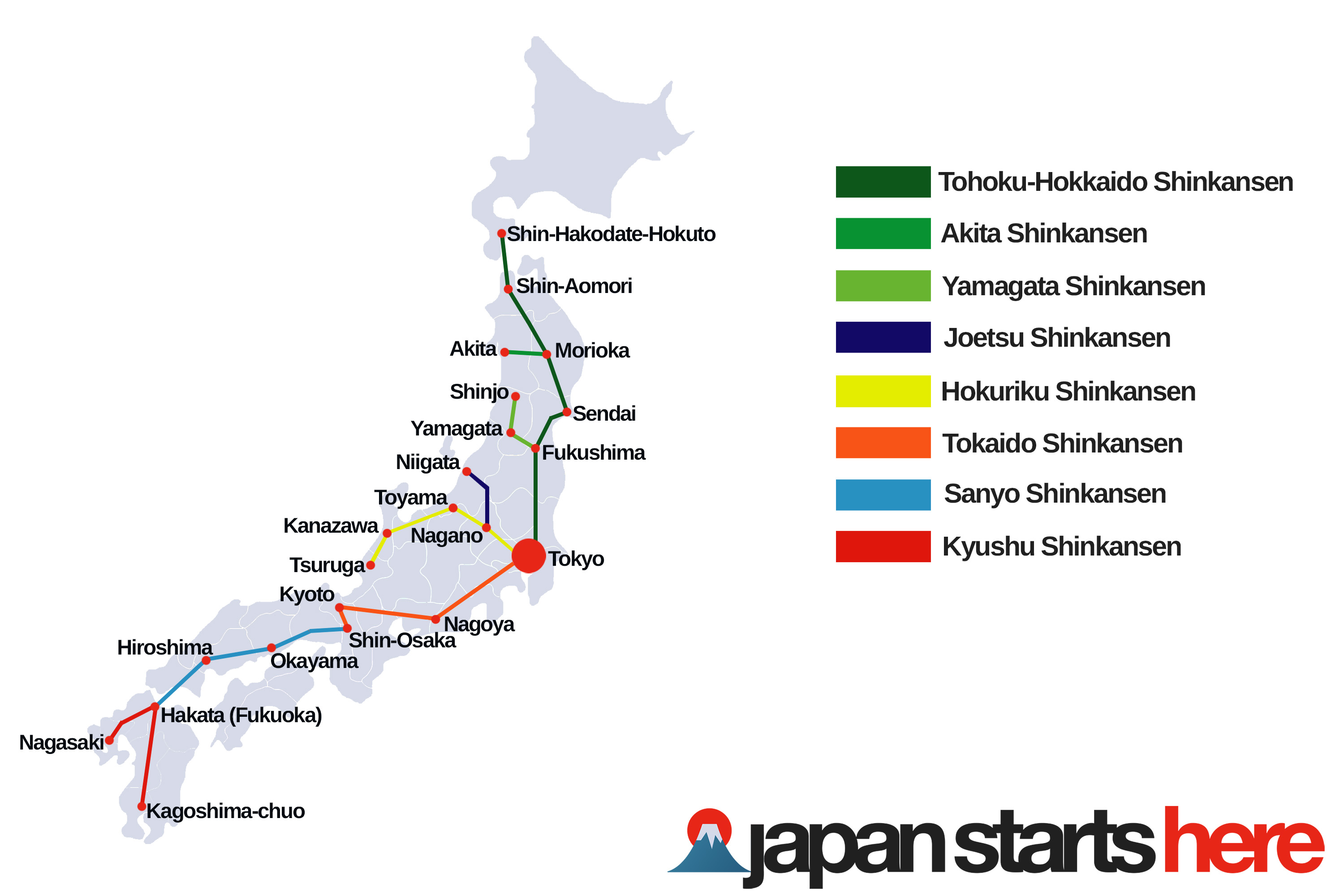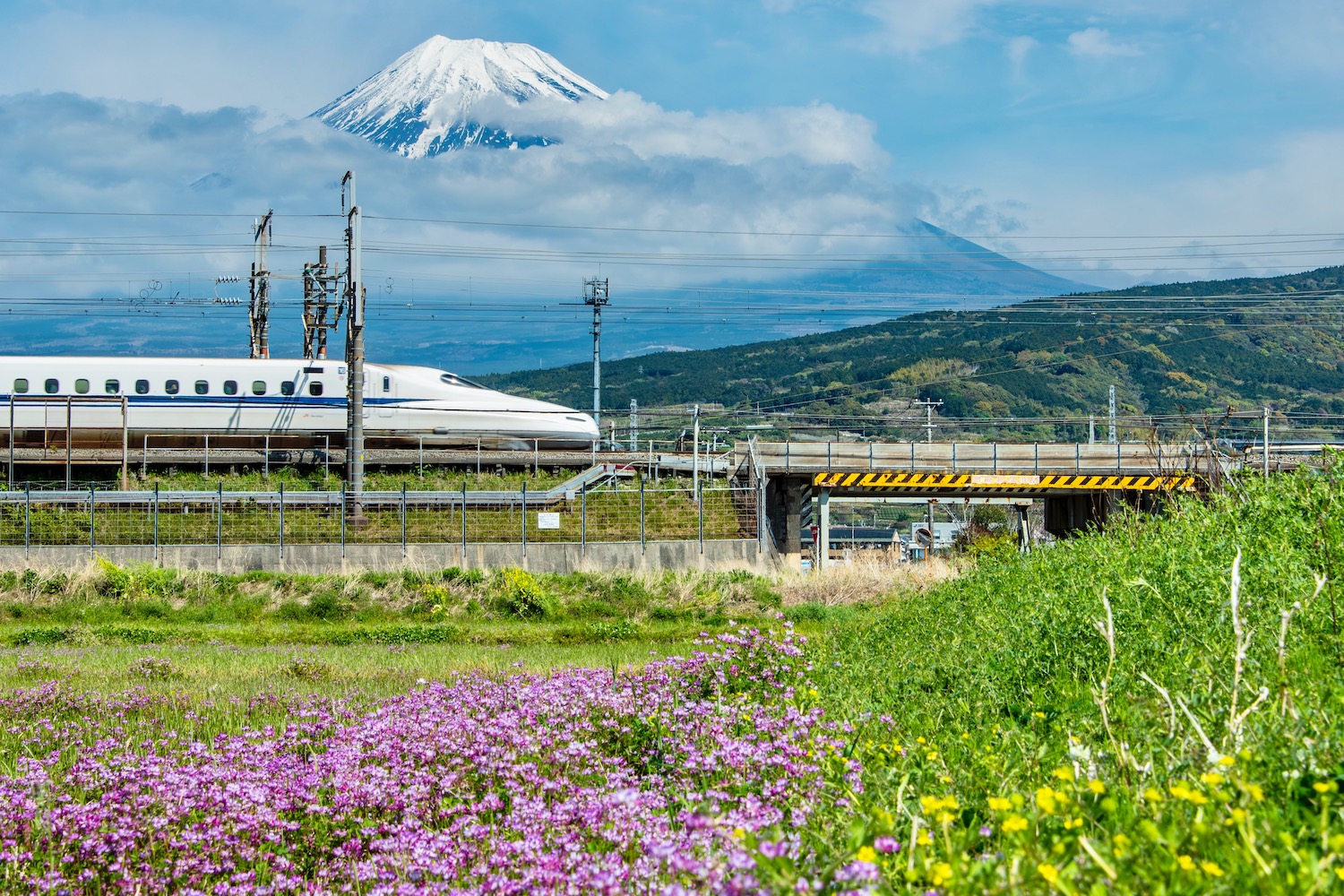Japan has the best high-speed train network—the best train network, writ-large—in the world, and it’s not particularly close. But contrary to popular belief, you can’t ride the Shinkansen “everywhere” in Japan.
In fact, there are some huge holes in the bullet train route network. And while Local and Tokkyu (Limited Express) trains fill most of them, there are times when you have to take a bus or even rent a car (which isn’t nearly as scary in Japan as you might think it is).
But that’s a topic for another post. Today, I’m here to answer a more fundamental question: Where does the Shinkansen go? (And, importantly, where doesn’t the Shinkansen go?)
Places in Japan You Can’t Reach by Shinkansen
Never heard of the Narita Airport Shinkansen? It’s not a coincidence. While such a line was once in development, you can’t reach Narita (or any Japanese airport) by bullet train. Thankfully, of course, virtually every airport in Japan is accessible via express bus and/or train services. But no Shinkansen—not a single one, to any airport in Japan.
Likewise, many other major destinations in Japan are inaccessible by Shinkansen. These include the Mt. Fuji, which is accessible via Limited Express train from Tokyo’s Shinjuku Station, and by highway bus from Mishima Station, which is a Shinkansen hub. Likewise, the huge Hokkaido city of Sapporo lacks a Shinkansen Station, and will until at least sometime in the 2030s.

Breaking Down Japan’s Shinkansen Routes
Tokaido-Sanyo-Kyushu Shinkansen
This is the “main” Shinkansen Line, which runs from Tokyo Station all the way to Kagoshima-chuo Station, albeit not directly. You either need to change trains at Shin-Osaka Station (the western terminus of the Tokaido Shinkansen) or at Fukuoka‘s Hakata Station, the last station along the Sanyo Shinkansen route, and the furthest west you can go from Tokyo without a transfer.
Hokuriku Shinkansen
Formerly known as the Nagano Shinkansen, this bullet train route travel first through the Japanese Alps (via, not surprisingly, Nagano Station) and then up to the Sea of Japan, with the busiest stations being Toyama Station and Kanazawa Station, i.e. the hubs of the Hokuriku region. In March 2024, this route was extended into Fukui prefecture, all the way to Tsuruga Station.
Joetsu Shinkansen
Although it does pass through the city of Joetsu, I sometimes feel like it would be more appropriate to call this route the Niigata Shinkansen, since Niigata Station is where most travelers around bound for. This line also passes through the mountains of Nagano prefecture, making Niigata-ken a convenient next stop from there. Continuing up the coast, meanwhile, necessitates transferring to traditional trains.
Tohoku-Hokkaido Shinkansen
The bad news? You can’t (yet) ride the Shinkansen to Sapporo. The good news? The Tohoku-Hokkaido Shinkansen will take you almost all the way there. Specifically, it takes around four hours to reach Shin-Hakodate-Hokuto Station, the only Shinkansen station in Hokkaido, via Tohoku region hubs like Sendai, Fukushima and Morioka. From there, it’s ~3 hours on a Tokkyu (Limited Express) train.
Mini-Shinkansen (Akita and Yamagata)
The Akita Shinkansen and Yamagata Shinkansen are referred to as mini-Shinkansen routes for two reasons. First, because they are branch lines, from Morioka and Fukushima Stations, respectively. Secondly, because they travel much more slowly than the main Tohoku Shinkansen. Still, they’re useful for reaching destinations including Ginzan Onsen and the Kakunodate Samurai district.

Future Shinkansen Extensions
The Shinkansen still doesn’t go everywhere in Japan—and realistically, it never will. Still, it will expand notably in the coming decades:
- Hokkaido Shinkansen: Although the original target date of 2030 has been moved, it shouldn’t be longer than another decade before you can travel by bullet train to Otaru and Sapporo.
- Chuo Shinkansen: This Maglev Shinkansen (which will connect Tokyo to Nagoya in less than an hour—and, at some point, to Osaka and Kyoto in a bit longer than that) has also been delayed.
- Hokuriku Shinkansen: At some point, the Sea of Japan Shinkansen Line will connect Tsuruga and Fukui to Kyoto and Osaka, but it’s looking like this will only happen in the 2040s.
- Shikoku and San’in Shinkansen: Sadly, it’s unlikely that bullet trains will ever travel onto Shikoku island, or to northwestern Honshu cities like Tottori, Matsue or Izumo.
As to whether the Maglev Shinkansen will eventually go beyond Kyoto and Osaka? Well, my crystal ball is a little fuzzy.

Other FAQ About Where the Shinkansen Goes (and Doesn’t Go)
What cities does the Shinkansen go to?
The Shinkansen travels from Tokyo to most major cities in Japan, including popular tourist destinations like Kyoto, Osaka, Hiroshima and Fukuoka, as well as to destinations in the Tohoku region, such as Sendai, Morioka, Yamagata and Akita. It also technically reaches Hokkaido island (specifically, the southern city of Hakodate), though it does not go all the way to Sapporo.
What is the longest Shinkansen route?
The Tohoku-Hokkaido Shinkansen route is the longest Shinkansen route, traveling from Tokyo Station all the way to Shin-Hakodate-Hokuto Station on Hokkaido island, a distance of over 800 km. This route is also where the Shinkansen hits its highest speed of more than 300 km/hr.
What is the most popular Shinkansen route?
The most popular Shinkansen route, by far, is the Tokaido Shinkansen, which travels from Tokyo Station to Shin-Osaka Station, via Nagoya and Kyoto. This is also the original Shinkansen, which first opened in 1964 to global fanfare.
The Bottom Line
Where does the Shinkansen go? The short answer is that it goes to most major tourist destinations in Japan, and everywhere along the “Golden Route” from Tokyo to Kyoto, Osaka and Hiroshima. The bad news is that there are some relatively major holes in the bullet train’s route map—it doesn’t go to any airport, nor to Mt. Fuji, nor onto the islands of Shikoku or Hokkaido (well, beyond Hakodate, the southernmost city of Japan’s northernmost island). Need personalized assistance with the logistics of your next Japan trip? Hire me to plan it!






